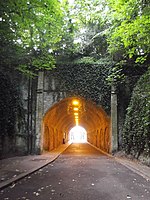Reigate Heath
Local Nature Reserves in SurreySites of Special Scientific Interest in Surrey

Reigate Heath is a 61.7-hectare (152-acre) biological Site of Special Scientific Interest west of Reigate in Surrey. An area of 51.6 hectares (128 acres) is also a Local Nature Reserve. Seven bowl barrows dating to the Bronze Age are designated Scheduled Monuments.Most of the site is heath and acidic grassland, with some areas of woodland and marshy meadow. One part is a golf course. The heath is mainly ling, bell heather and wavy hair-grass. Marshy meadows have Yorkshire fog, sharp-flowered rush, meadowsweet, wild angelica and marsh marigold.There is public access to most of the site apart from the golf course.
Excerpt from the Wikipedia article Reigate Heath (License: CC BY-SA 3.0, Authors, Images).Reigate Heath
Flanchford Road, Reigate and Banstead South Park
Geographical coordinates (GPS) Address Phone number Website Nearby Places Show on map
Geographical coordinates (GPS)
| Latitude | Longitude |
|---|---|
| N 51.237 ° | E -0.231 ° |
Address
Reigate Heath
Flanchford Road
RH2 8QR Reigate and Banstead, South Park
England, United Kingdom
Open on Google Maps








